Take it offline!
This Education in Motion resource is also available as a printable PDF.
Download PDF
One of the most important factors to consider when choosing a power wheelchair is the drive wheel position. This decision will impact the chair's performance over obstacles, on hills, at higher speeds, and on uneven terrain. It will also affect access into smaller spaces.
Wheelchair manufacturers can now make power wheelchairs with four drive wheel positions. The drive wheel location is described in relation to the user's sitting position.
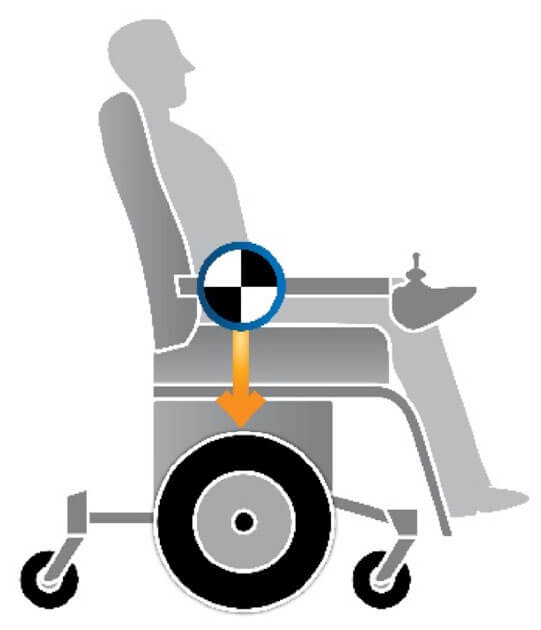
Mid Wheel Drive (MWD)
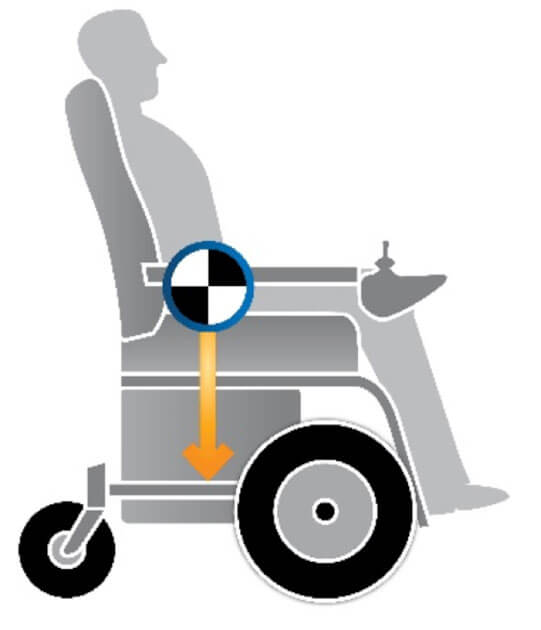
Front Wheel Drive (FWD)
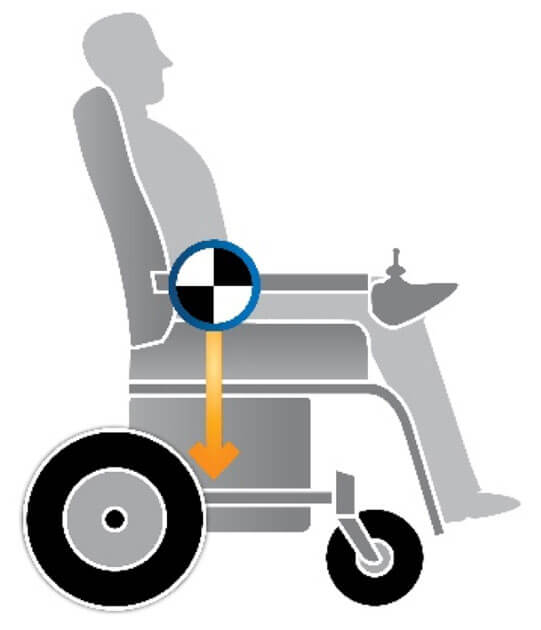
Rear Wheel Drive (RWD)
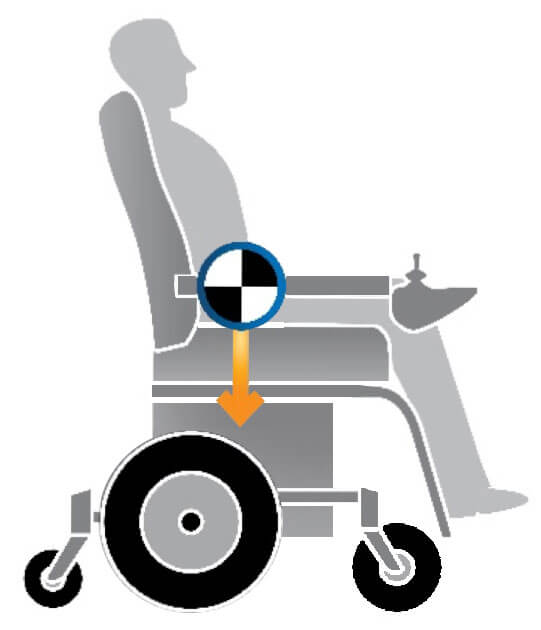
Hybrid Wheel Drive (HWD)
Mid wheel drive (MWD) has the client's center of gravity over the drive wheel. Front wheel drive (FWD) has the client's center of gravity well behind the drive wheel. Rear wheel drive (RWD) positions the client's center of gravity ahead of the drive wheel. Hybrid wheel drive (HWD) has the drive wheel position in between that of a MWD and RWD.
The following breakdown describes how the drive wheel position affects the performance of the wheelchair. This should be considered a guide only, realizing that many other wheelchair features and client goals need to be considered before prescribing a power wheelchair.
Maneuverability is determined by how a wheelchair turns and how much space is required to turn. This maneuverability will affect how easy it is to get into tight spaces. It can be "measured" by looking at the turning radius (center of the drive wheel to the furthest point of the wheelchair).
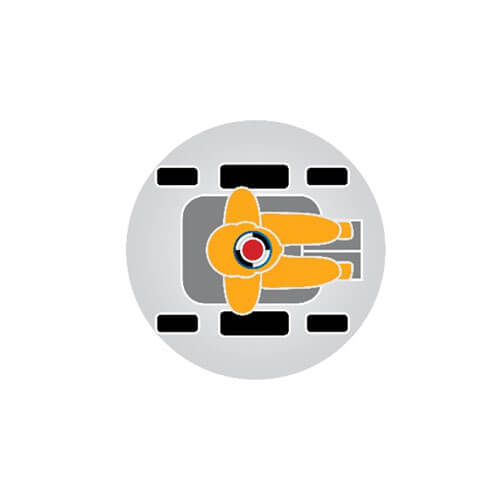
Mid Wheel Drive (MWD)
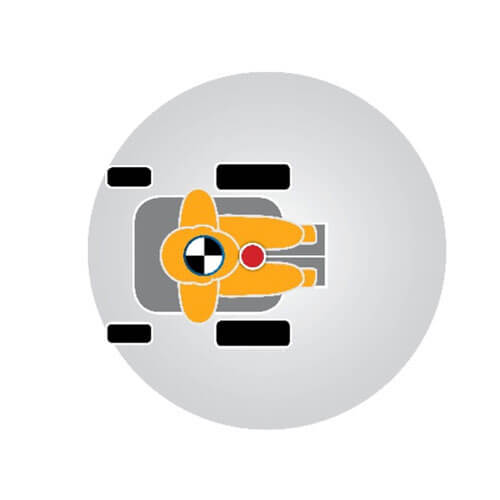
Front Wheel Drive (FWD)
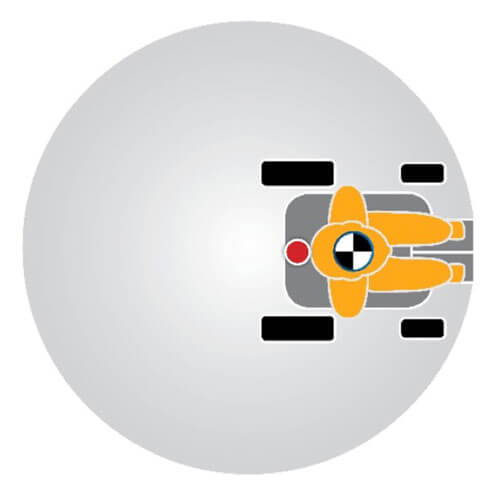
Rear Wheel Drive (RWD)
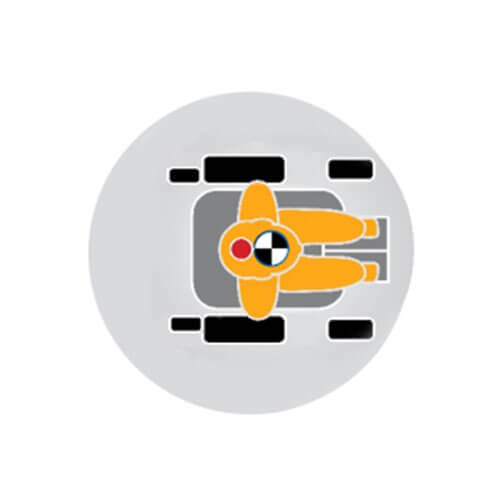
Hybrid Wheel Drive (HWD)
Turning Radius
MWD
The smallest turning circle option, as the user's center of gravity is closest to the chair's center point. As a result, it is considered more intuitive for the user. Easiest to learn.
FWD
Longer turning radius because of the base length. Shorter than RWD because casters can be closer than RWD.
RWD
Longest turning radius because of the base length and the need for the casters not to clash with the leg rests.
HWD
Longer turning radius because of the base length. Shorter than RWD because casters can be closer than RWD.
Ease of Turning
MWD
User's center of gravity is closest to the chair's center point, so chair turns where client is sitting. Most intuitive to drive. Easiest to learn.
FWD
The back end of the wheelchair swings during turning. The front drive wheel must clear the doorway before the turn can start. Drivers have to learn to "turn late." This style of chair is more challenging for clients with cognitive or perceptual difficulties. Requires learning a strategy.
RWD
The front end of the wheelchair swings so that users must drive through the doorway before they begin to turn and stay wide to the door opening when turning. It's easier than a FWD because the client can see the chair in front of them and better gauge turning space.
HWD
Hybrid is more intuitive to drive than a RWD but a bit less intuitive than MWD. Because the user is sitting a bit in front of the drive wheel, it will have some of the feel of a RWD.
Handing Obstacles
Handling obstacles is determined in large part by the size of the wheel that encounters the obstacle and by the suspension built into the chair.
MWD
The caster wheels are smaller with MWD, so the chair will rely on the wheelchair suspension to manage obstacles - look for dynamic articulation (movement) of the caster wheels so that they can move and allow the drive wheel to stay loaded and "push" up the obstacle.
FWD
The drive wheels should contact the obstacle first in a FWD, so they typically can manage obstacles well. If the front hangers are positioned low, this might reduce the ability of the drive wheel to reach the obstacle, reducing its performance.
RWD
Again, the smaller caster wheels will encounter the obstacle first, so the chair will have to rely on suspension to keep the drive wheels loaded to push up the obstacle. Base suspension can help.
HWD
The base is a bit shorter and has dynamic back stabilizers, so the chair will be able to navigate obstacles better than its RWD counterpart.
Traction
Traction in large part is determined by how well the drive wheel remains loaded when going up or down inclines or hills. If a lot of the weight of the wheelchair comes off the drive wheels, the chair can lose traction and get stuck.
MWD
Does well for traction both up and down inclines if the drive wheel remains loaded, so its performance is very dependent on good suspension (articulation of the casters). If the weight gets shifted to front and rear casters, this type of chair can lose traction.
FWD
Does well on inclines until very steep, then the chair can lose traction as weight shifts to the smaller casters. Steeper declines can perform poorly as chair can feel tippy forward.
RWD
Good traction and best on inclines because center of gravity shifts towards the drive wheels. On steeper declines, it can lose traction and perform poorly if too much weight is shifted to the casters.
HWD
Does well, as it combines the benefits of a RWD with the suspension added to the rear caster arms.
Control at Higher Speeds
Control at higher speeds is determined by many of the factors we have already discussed.
MWD
Does quite well with directional control at higher speeds. When you add in how intuitive it is to drive, this becomes an easy chair to control.
FWD
Worst directional control at higher speeds. Chair may "fishtail," although advanced electronics and programming can help.
RWD
Best directional control at higher speeds.
HWD
Nearly as good as its RWD counterpart at control with speed.
Ease of Attendant Drive
This can be a really important consideration if caregivers are going to be moving the power wheelchair - particularly in tight spaces like bedrooms or vans.
MWD
This drive wheel position can be tricky to drive from an attendant control located at the back of the chair because the control is so far behind the turning center of the wheelchair.
FWD
This drive wheel position can be tricky to drive from an attendant control located at the back of the chair because the control is so far behind the turning center of the wheelchair. Chair may "fishtail," although advanced electronics and programming can help.
RWD
This drive wheel position offers the easiest management/directional control for an attendant joystick mounted at the back of the chair.
HWD
Nearly as good as its RWD counterpart with attendant joystick control.
As with all AT decisions, there are always considerations and compromises. But by understanding the key features and benefits of each of the drive wheel positions, you can give advice to clients about which might best suit their lifestyle and usage.
References
- Lange, Michelle; Minkel, Jean, Seating and and Wheeled Mobility: A Clinical Resource Guide; Slack Incorporated 2017
- Koontz AM, Brindle ED, Kankipati P, Feathers D, Cooper RA. Design Features that Impact the Maneuverability of Wheelchairs and Scooters. Archives of Physical Medicine and Rehabilitation May 2010; 91:759-64.
- Wiart L, Darrah J, Cook A, Hollis V, May L. Evaluation of powered mobility use in home and community environments. Physical & Occupational Therapy in Pediatrics. 2003; 23(2):59-75.
- Spinal Seating Modules, ACI state Spinal Cord Injury Service NSW Government Australia https://www.aci.health.nsw.gov.au/networks/spinal-cord-injury/spinal-seating
- Torkia, Ried, Korner-Bitensky, Power wheelchair driving challenges in the community: A Users' Perspective. Disability and Rehabilitation, 2014, Assistive Technology 10(3)